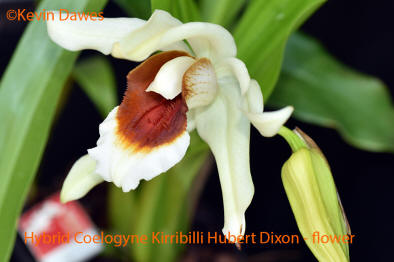For a number of years the 1950 primary hybrid, Coelogyne Memoria Wilhelm Micholitz (produced by the famous Sanders and Sons in UK), has dominated and impressed in my glasshouse. The more this plant developed the more spectacular became its display and over many months of each season. The beautifully displayed flowers have been very large and attractive. It was created by pollinating Coelogyne lawrenceana with Coelogyne mooreana - both well known and spectacular flowers in their own right.
I have crossed this beautiful hybrid with a species orchid, Coelogyne eberhardtii, which is extremely closely related to the original pollen plant (Coelogyne lawrenceana).
The size of the flowers on the new hybrid is enormous, even bigger than the huge flowers of the pod parent. The sepals and petals are around 70mm long. The lip is 40mm wide and 70mm from the base of the throat to the tip. These measurements form an impressive bulk of flower mass around 200mm across.
Apart from the very obvious size difference, the new hybrid retains much of the appearance of Coelogyne Memoria Wilhelm Micholitz. It has the same extensive tobacco/orange throat colouring. There are slight hints of green in the sepals and petals from the pollen parent and the column has moved away from the slightly yellowish colouring of the hybrid's pod parent to a white similar to Coelogyne eberhardtii and also to its grandparent, Coelogyne mooreana. The dorsal sepal folds over the column strongly and this trait is very evident in both grandparents and the pollen parent. The strong, almost red throat colouring of Coelogyne eberhardtii has disappeared but possibly left a darker overall brownish colour in the offspring compared to that of Coelogyne Mem W Micholitz with its tendency to a slightly more orange colouring.
The keels have lost their multiple rows and uniform structure with many hairs from Coelogyne mooreana and/or Coelogyne Mem W Micholitz. The hybrid has two strong keels from the base of the throat to the mid lobe but the hairs on these are fewer, thicker and more defined than on Coelogyne mooreana or Coelogyne Mem W Micholitz. However, the centre and two outside keels are discontinuous and fragmented. They indicate some influence from Coelogyne eberhardtii.
The bracts are deciduous on a synanthous growth pattern in keeping with that of both its parents.
The flower has a mild, pleasant perfume to add to its attractiveness.
This hybrid was pollinated on 24.07.2011, flasked 30.06.2012 (11 months), deflasked on 09.10.2013 and flowered for the first time on 17th November 2016 - a process completed in just over 5 years. This is a little quicker than usual and on big strong seedlings.
Negatives: This is a large plant and may require a reasonable amount of space. All its relatives are from northern Vietnam but up to some altitude. It will need total protection from frosts and a high humidity.
Rating: ♦♦♦♦♦ This is the largest Coelogyne flower that I have seen. This plant has continued to impress as it has matured. It flowers very freely. The numerous spikes that develop one or two huge flowers sequentially makes an impressive sight over many months. It is hardy and floriferous and makes an excellent specimen plant.
Registration: Registration with the RHS was recorded in December 2016. This hybrid was named in honour of Reverend Hubert Dixon, my father-in-law . He saw active service with the Royal Australian Air Force during World War II and mentored many students at Sydney's Barker College as the school's chaplain. He was dearly missed by many when his life was suddenly cut short.
Varieties: None known.
Hybrids: None registered
| < Coel Kirribilli Gladys Davies | Coel Kirribilli James > |

